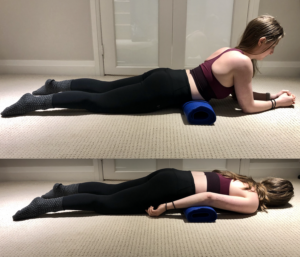Breathe Right + Diaphragmatic Release
Breathing is something we do every single day, without even thinking about it. Our breath is the key to life, sending oxygen to our muscles and brains in order for us to do everything. Breathing is also an amazing way to slow the sympathetic nervous system, heart rate and lessen anxiety levels when needed. When we are exercising, or stressed, we often will take shorter quicker breaths from our chests. This is efficient when we need oxygen quickly for cardiovascular reasons, but if we are breathing this way in our relaxed state it can be a sign of hyperactivity, stress or anxiety.
The diaphragm is one of our major breathing muscles. It is the primary muscle used in inspiration. It is attached inside the body onto our spine and our lower ribs. When we take an inhalation, our diaphragm will drop (towards your toes) to create space for the lungs to expand. When we exhale, the diaphragm will rise and relax and expel air out of the lungs. If we are not getting these diaphragmatic movements and instead are breathing using our chest, we are not getting the tensile properties of this muscle working properly. This can create a lot of tension within the diaphragm, and extending to the attachment points in the spine and ribs where the diaphragm attaches, causing less mobility throughout our midsections as a whole.
HOW TO BREATHE PROPERLY:
A great way to loosen up the diaphragm is just through breathing, but breathing properly! Lie on your back and place your hands on your lower ribcage and belly. Try taking a few breaths focusing on the breath filling up the space underneath your hands. Think about breathing from your belly as opposed to your chest! You can also place one hand on your chest and one hand on your belly to feel which one is rising; if the hand on your chest is rising with no movement in your lower ribs and belly, go back to both hands on your belly to aim your focus back to deep belly breathing. This is a great exercise to begin a meditation, or for relaxation in these stressful holiday times.
GENTLE DIAPHRAGMATIC RELEASE:
A second way to alleviate tension in the diaphragm is through a gentle diaphragmatic release. An easy way to do so is to take a yoga mat that is curled up, and place it right below your ribcage. It should lie across your stomach, above your belly button and below your ribcage. Once it is in a nice position you will lie on top of it in that position, on your stomach. The yoga mat will push gently up into your diaphragm. To begin you can rest on your elbows so your full body weight isn’t being used for this release, and once you gain comfort in this position you can lie flat on your stomach. The goal is to again breathe deeply in this position. The diaphragm will be pressed against the mat while extending and in this way, massaging itself against any points of tension. You can also rotate or move the mat if you feel spots of greater tension once you begin breathing. This should not be painful! It may feel uncomfortable but you should try to breathe as deeply and normally as possible. Repeat this for 10 big breaths and then remove the mat.
NOTE: If you are feeling extra stiff try taking a warm Epsom salts bath or shower to warm up your muscles prior to these exercises. Move in and out of each exercise carefully. All exercises should be PAIN FREE. If you feel pain during any of these exercises please STOP performing the exercise.
These exercises will free up the diaphragm allowing you to breathe more efficiently and deeper. This promotes relaxation, and is a great exercise to do to relieve stress and get you relaxed and ready for the new year!
Please feel free to contact me at Therapy Lounge if you have any questions about these exercises, or if you would like to book a treatment.






Comments are closed.